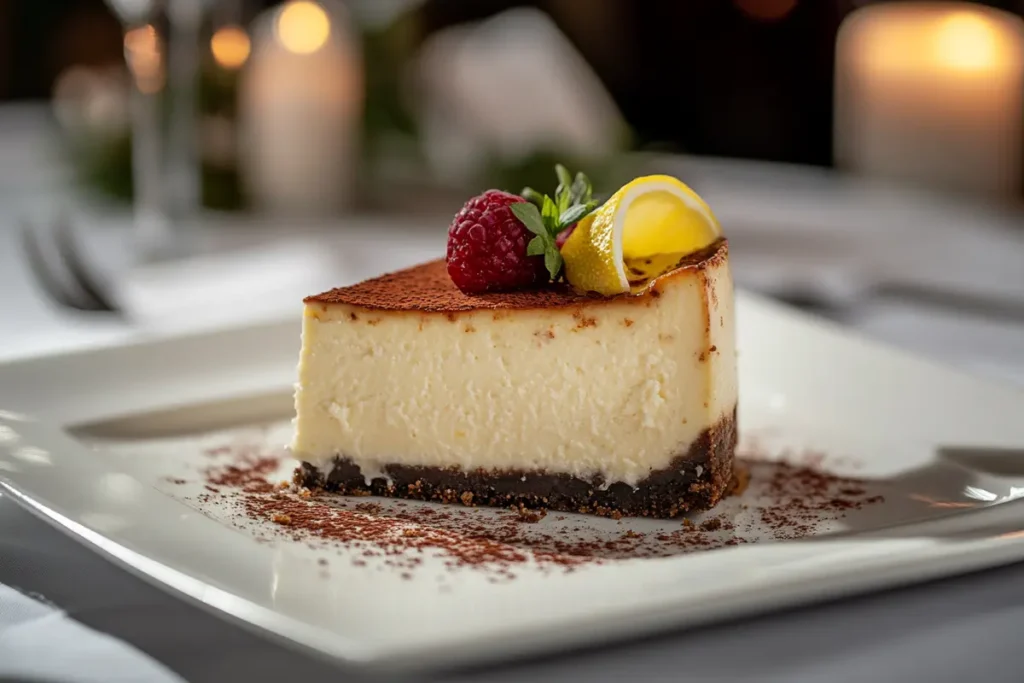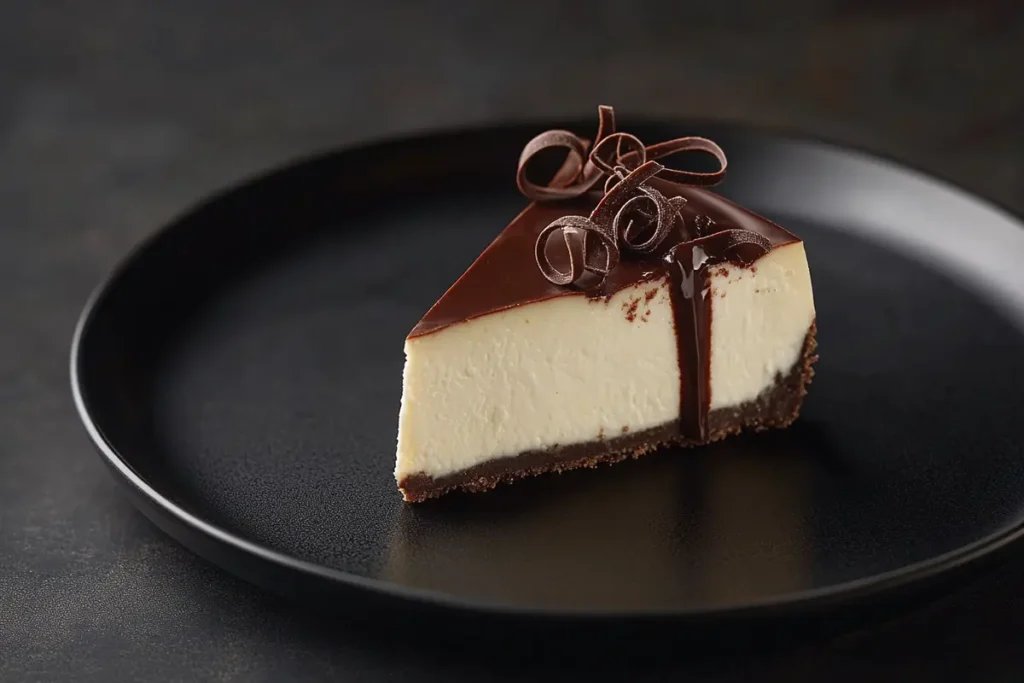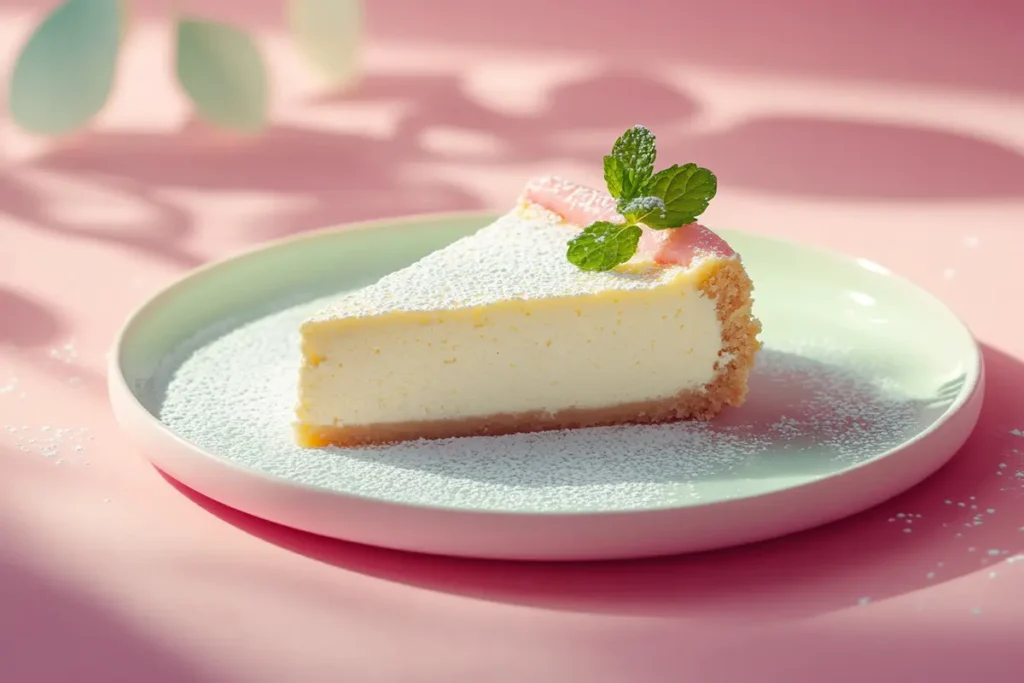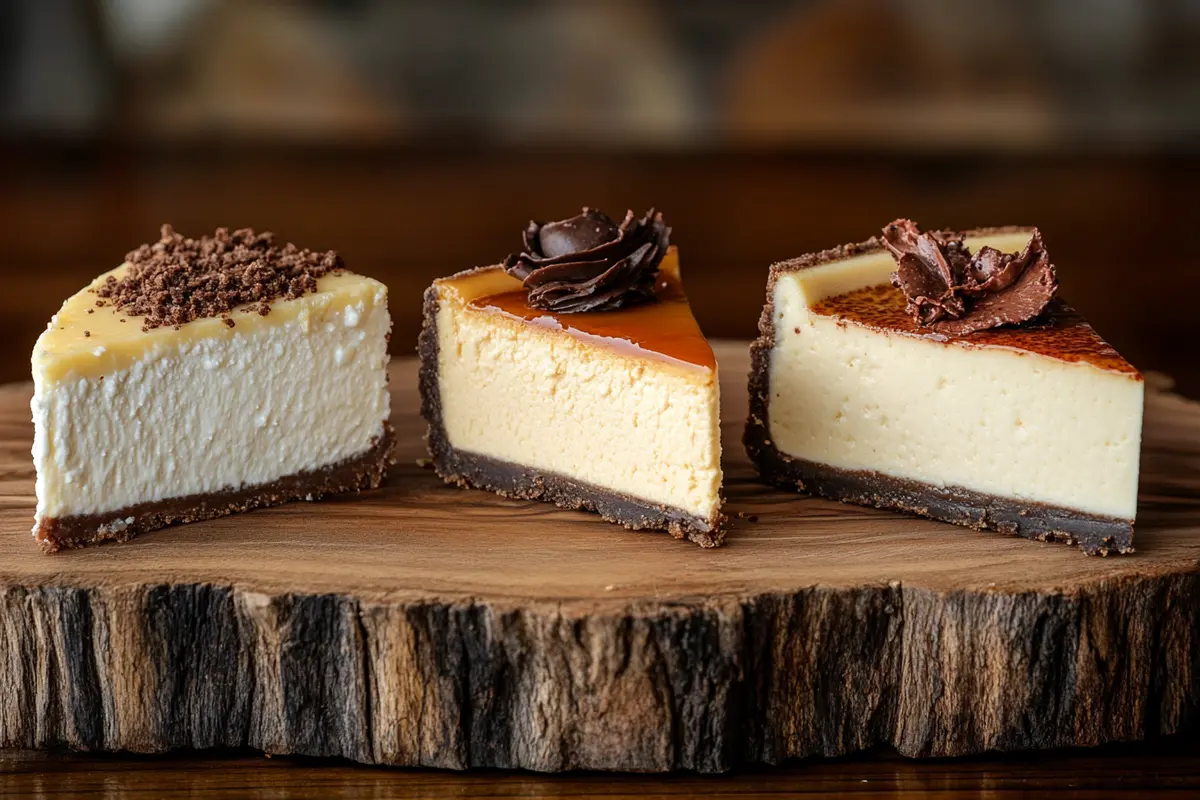Cheesecake is a beloved dessert that has captivated dessert lovers for generations. In the United States, this creamy confection has a special place at family gatherings, holidays, and fancy restaurant menus. Yet, many people still wonder: What are the three types of cheesecake? Understanding these major categories can help you pick the perfect dessert for your next celebration. In addition, knowing their differences reveals much about their origins, ingredients, and preparation techniques.
Why Understanding the Three Main Cheesecake Types Matters
Many home bakers assume that all cheesecakes taste the same. In reality, each of the three types of cheesecake differs in texture, flavor profile, and even baking method. Therefore, knowing these variations empowers you to select the right cheesecake for a special event. Moreover, it helps you appreciate the dessert’s evolution over time.
For example, if you prefer a thick, indulgent slice, the New York style might be your top choice. On the other hand, if you love a soft, creamy interior with a firm exterior, the Chicago style is sure to impress. Meanwhile, if you favor a lighter approach, the Italian cheesecake, with its ricotta-based filling, might be perfect. In addition, exploring these styles can encourage you to experiment with different recipes at home. This can spark culinary creativity and lead to discovering your personal favorite. After all, the question What are the three types of cheesecake? is not just about classification; it’s about embracing variety.
Key Ingredients That Define Each Cheesecake Types
Although all cheesecakes start with simple ingredients—cheese, sugar, eggs, and a crust—the type of cheese used makes a big difference. For instance, New York cheesecake typically calls for pure cream cheese. This lends it that iconic dense and velvety mouthfeel. However, Chicago style cheesecake may incorporate sour cream to achieve a fluffier but still rich texture. In contrast, Italian cheesecake often uses ricotta cheese, adding a lighter, slightly grainy consistency that some people find refreshing.
In addition, the crust and toppings vary. The crust in a New York style cheesecake often features graham cracker crumbs. This base provides a crunchy, buttery contrast to the rich filling. On the other hand, Chicago style cheesecake sometimes uses a firmer crust that can hold up to the dessert’s airy interior. Italian cheesecake might skip the traditional graham cracker crust in favor of a pastry crust. Moreover, toppings like fresh fruit, chocolate shavings, or simple sour cream layers can add depth. Therefore, the next time someone asks, What are the three types of cheesecake? you’ll know it’s about more than just cheese—it’s about a whole spectrum of flavors and textures.
The Legendary New York Cheesecake
Origin and Evolution of New York Cheesecake
When pondering What are the three types of cheesecake?, many people first think of New York cheesecake. This style emerged in the early 1900s, flourishing in Manhattan’s delicatessens and diners. Over time, it became known as the gold standard for American cheesecakes. Moreover, thanks to its popularity, you can now find it in bakeries and restaurants across the country.
This cheesecake is famously dense and creamy, often made with full-fat cream cheese. Therefore, it has a rich, indulgent taste that satisfies serious dessert enthusiasts. In addition, New York cheesecake usually omits extra flavors like chocolate or caramel. Instead, it focuses on letting the cream cheese and subtle vanilla flavors shine. As a result, many connoisseurs consider New York cheesecake the purest form.
Characteristics of New York Cheesecake
- Texture: Dense and ultra-creamy.
- Main Cheese: Cream cheese.
- Crust: Typically graham cracker.
- Flavor Profile: Rich, tangy, and mildly sweet.
Therefore, if you want the classic American cheesecake experience, the New York style remains the go-to choice. Its solid reputation answers part of the question, What are the three types of cheesecake?, by setting a high standard.
Baking Tips for the Perfect New York Cheesecake
Achieving the perfect New York cheesecake requires attention to detail. For example, always use room-temperature ingredients to ensure a smooth batter. In addition, bake it in a water bath, also known as a bain-marie. This method helps maintain a moist, creamy texture. Furthermore, let it chill in the fridge overnight before slicing. Patience pays off, as it allows the flavors to deepen and the texture to set. By following these tips, you’ll better understand What are the three types of cheesecake? and how to master them.

The Classic Chicago Style Cheesecake
A Brief History of Chicago Style Cheesecake
The second answer to the question What are the three types of cheesecake? often involves the Chicago style cheesecake. While less famous than its New York cousin, it holds its own unique charm. Chicago style cheesecake gained fame in the Midwest, reflecting the region’s love for hearty, comforting desserts. Over the years, local bakers adapted the recipe, developing a cheesecake that is firm on the outside and delightfully creamy on the inside.
However, Chicago style cheesecake is not simply a copy of New York cheesecake. Instead, it uses slightly different techniques and ingredients to create a more airy, less tangy result. Moreover, this style often includes sour cream in the filling, balancing richness with a subtle tang. In addition, this cheesecake sometimes features a more substantial crust that can stand up to its interior softness.
Characteristics of Chicago Style Cheesecake
- Texture: Firm exterior, creamy interior, slightly fluffy.
- Main Cheese: Often cream cheese plus sour cream.
- Crust: Thicker, sometimes more substantial than New York style.
- Flavor Profile: Milder than New York, with a hint of tanginess.
Therefore, if you appreciate a dessert that feels luxurious but not too heavy, Chicago style cheesecake might become your favorite. On the other hand, some prefer the strong punch of New York style. Either way, including Chicago style in the trio when discussing What are the three types of cheesecake? adds depth to the dessert’s story.
Tips for Baking a Great Chicago Style Cheesecake
For best results, invest in high-quality cream cheese and sour cream. In addition, use a light hand when mixing the batter to maintain an airy texture. Therefore, do not overmix. Moreover, consider baking it at a slightly lower temperature for a longer time. This approach helps the cheesecake set without overbrowning. Finally, like other cheesecakes, allow it to cool slowly and rest overnight in the fridge. This ensures the right balance of firmness and creaminess.

The Delicate Italian Cheesecake
Tracing the Origins of Italian Cheesecake
The third answer to What are the three types of cheesecake? often points toward the Italian cheesecake. Rooted in Italy’s culinary traditions, this cheesecake is notably different. Instead of relying solely on cream cheese, it usually employs ricotta. This choice reflects Italy’s dairy culture and results in a cheesecake that feels lighter and fluffier.
Historically, Italian cheesecake evolved from various regional recipes. Different parts of Italy may use distinct cheeses, such as ricotta di pecora (sheep’s milk ricotta), to achieve unique flavors. Moreover, Italians often infuse their cheesecakes with citrus zest or candied fruit, adding brightness and complexity. Therefore, Italian cheesecake stands out as a refined, elegant dessert.
Characteristics of Italian Cheesecake
- Texture: Light, slightly grainy, and airy.
- Main Cheese: Ricotta (sometimes mixed with mascarpone).
- Crust: Often a pastry crust instead of graham crackers.
- Flavor Profile: Subtle, with hints of citrus or vanilla, less tangy than American styles.
As a result, Italian cheesecake tastes more delicate and less sweet than its American counterparts. Therefore, those who find New York cheesecake too heavy or Chicago style too rich may appreciate Italian cheesecake’s subtlety. Its inclusion in the trio when exploring What are the three types of cheesecake? highlights the dessert’s international appeal.
Tips for Perfecting an Italian Cheesecake
When baking Italian cheesecake, choose the freshest ricotta available. In addition, drain it well to remove excess moisture. This step ensures a smooth, creamy filling. Furthermore, consider adding lemon zest for a bright flavor or a splash of vanilla extract. Bake until just set, and allow it to cool completely before serving. By doing so, you’ll enhance the delicate flavors and truly appreciate this sophisticated cheesecake style.

Comparing the Three Main Cheesecake Types
To fully answer the question, What are the three types of cheesecake?, it helps to compare them side by side. Each style offers distinct characteristics that cater to different tastes.
New York Cheesecake:
- Heavy and rich.
- Uses cream cheese for a dense, decadent filling.
- Signature graham cracker crust.
- Pure, tangy flavor with no frills.
Chicago Style Cheesecake:
- Exterior is firm, interior is creamy and airy.
- Adds sour cream for a lighter texture.
- Often has a thicker crust.
- Mild flavor, slightly tangy but not overpowering.
Italian Cheesecake:
- Light, airy, and delicate.
- Relies on ricotta for a subtler taste.
- May include citrus or other mild flavors.
- Less sweet, often with a pastry crust.
Variations Within Each Cheesecake Type
Although we’ve identified What are the three types of cheesecake?, remember that each style has countless variations. For instance, some bakers experiment with adding chocolate swirls or berries to New York cheesecake. Others might incorporate nut flours in the crust for a unique twist. Chicago style cheesecake could include a layer of fruit preserves, while Italian cheesecake might feature almonds or even a touch of honey for sweetness.
Furthermore, regional preferences influence how these cheesecakes evolve. In addition, dietary restrictions have led to gluten-free crusts or low-sugar versions. Regardless of these changes, the core principles remain intact. Knowing the base type helps you appreciate creative variations while maintaining clarity about the dessert’s identity.
How to Choose the Right Cheesecake
When deciding which cheesecake to serve, consider your guests’ preferences. For example, if they love bold flavors, opt for New York cheesecake. However, if they prefer something lighter, offer the Italian style. On the other hand, if they enjoy a balanced dessert, Chicago style might be the best choice.
In addition, think about the meal as a whole. A heavy main course might benefit from the delicate Italian cheesecake for dessert, while a lighter meal could handle the richness of a New York cheesecake. Furthermore, consider pairing options. A strong coffee or espresso pairs well with a New York cheesecake, while a sweet dessert wine might complement an Italian cheesecake. This flexibility shows how answering What are the three types of cheesecake? can influence your entire dining experience.
Serving Suggestions and Presentation Tips
A cheesecake’s presentation can enhance its appeal. For example, top a New York cheesecake with fresh strawberries or a simple strawberry glaze. In addition, serve Italian cheesecake with a dusting of powdered sugar and a few raspberries for a subtle, elegant touch. Meanwhile, consider drizzling a light chocolate sauce over a slice of Chicago style cheesecake for added indulgence.
Moreover, the plate itself matters. A clean, white plate contrasts beautifully with the creamy filling, making the colors pop. Garnishes like mint leaves, citrus zest curls, or a swirl of fruit coulis add visual interest. Therefore, paying attention to detail ensures that your cheesecake not only tastes great but also looks inviting.
Storage and Shelf Life
Cheesecakes require careful storage to maintain their optimal texture and flavor. Always store them in the refrigerator, covered to prevent drying out. In addition, it’s best to consume them within a few days to ensure freshness. If needed, you can freeze cheesecake slices, wrapped securely in plastic wrap, for up to a month. Thaw them overnight in the fridge before serving. Therefore, by handling leftovers properly, you can extend the enjoyment of your chosen cheesecake style.
Healthier Cheesecake Alternatives
If you love cheesecake but want a lighter option, there are ways to adapt. For instance, reduce sugar or use a sugar substitute. In addition, choose low-fat cream cheese or even use Greek yogurt for part of the filling. A gluten-free crust can cater to dietary needs without sacrificing flavor.
Meanwhile, the Italian cheesecake style already leans toward a lighter texture. Therefore, for health-conscious dessert lovers, it’s a suitable starting point. After all, understanding What are the three types of cheesecake? helps you customize the dessert to fit your lifestyle and preferences.
Cultural Influences on Cheesecake
Cheesecake styles reflect cultural backgrounds. New York and Chicago cheesecakes emerged within American culinary traditions, emphasizing richness and indulgence. On the other hand, Italian cheesecake embodies the elegance and refinement of European desserts. Therefore, exploring these cheesecakes is also a journey through food culture and history.
For example, consider how ingredients available in each region shaped the recipe. Cream cheese is abundant in America, while ricotta is central to Italian kitchens. Over time, bakers adapted these ingredients to suit local tastes, resulting in distinct cheesecake identities. Recognizing these cultural layers adds depth to the simple question, What are the three types of cheesecake?
Frequently Asked Questions
What are the types of cheesecakes?
Many cheesecake types exist worldwide. However, the three main types are often considered the New York style, the Chicago style, and the Italian style. These differ in texture, ingredients, and flavor profiles. New York cheesecake is dense and rich, Chicago style is creamy yet airy, and Italian cheesecake is light and subtle. Choosing among them depends on your preference for density, sweetness, and tanginess.
What is the difference between New York and Chicago style cheesecake?
Both New York and Chicago styles use cream cheese, but they differ in texture and taste. New York cheesecake is dense, rich, and tangy, featuring a classic graham cracker crust. Chicago style cheesecake has a firm exterior but a creamier, fluffier interior. It often includes sour cream for added lightness. While New York style focuses on bold, pure flavors, Chicago style provides a milder, less intense experience.
What is the difference between Italian cheesecake and New York cheesecake?
Italian cheesecake uses ricotta instead of cream cheese, resulting in a lighter, airier texture and a subtle flavor. It often has a pastry crust and may include citrus zest or candied fruit. In contrast, New York cheesecake relies on cream cheese for a dense, velvety texture and a rich, tangy taste. Its graham cracker crust and pure flavor profile set it apart. Thus, while New York cheesecake feels indulgent and heavy, Italian cheesecake offers a more delicate, refined option.
Conclusion
Understanding What are the three types of cheesecake? leads you to appreciate New York, Chicago, and Italian cheesecakes as distinct but equally delightful desserts. Each offers its own charm, from the dense richness of New York to the airy elegance of Italian cheesecake. Therefore, the next time you serve dessert, consider which style best complements the meal or suits your guests’ preferences. In doing so, you’ll not only elevate your dessert game but also gain a deeper appreciation for the art of baking cheesecakes.

